Sarah Mohammad Alhejji
Department of Geography || West Chester University of Pennsylvania || USA
1- INTRODUCTION
In the 1990s, car sharing became popular in Zurich, Switzerland after people had started to use it in 1948 (Shaheen and Cohen 2008).Carsharing usage has increased recently in most of the countries. In Portland, Oregon State, opened the first commercial organization, Car Sharing Portland, in the United States in1998 (Katzev 2003). In the past decade, carsharing has significantly grown worldwide, as there has been an increasing demand to understand the impacts of environment as the carsharing has expanded. There are several counties with existing operations and the other countries have possibility of carsharing (figure1). Cersharing has already existed in the countries of North America (U.S and Canada), east and north Europe counties, Japan, and Australia (Shaheen and Cohen 2008).

Figure (1) State of carsharing world wide, Shaheen and Cohen 2008
In 2008, there were less than a million of carshiring members in the world, excluding Africa and South America with approximately 20, 000 carsharing vehicles in the same year (figur2). In the following six years, there was a significant increasing in both number of members and car sharing vehicles. In 2014, there were more the 92, 000 vehicles and about five million membership the same year (figure 2).
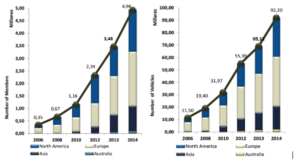
Figure (2) Carsharing Market, Number of Members and Vehicles from 2006-2014, (Le Vine et al. 2014)
In 2006, Europe had the heist percentage of membership followed by North America, 61% and 34% respectively (figure 3). However, this percentages rose in North America by 51% and dropped in Europe by 39% ( Shahen & Cohen, 2012)..
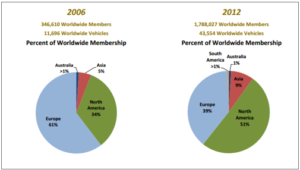
Figure (3) Worldwide carsharing: six year of growth, ( Shahen & Cohen, 2012)
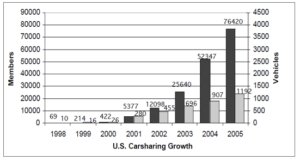
Figure (4) US car-sharing growth, Shaheen et al. 2006
North America is the largest region of worldwide membership in car-sharing (Shaheen & Cohen, 2012). In the United States, the percentage of the growth in car-sharing members increased in the past years between 2001 to 2005 (figure 4). For the following years, it rose between July 2011 and 2012 in the same month by about 44% while Canada had 28.7% ( Shaheen & Cohen, 2012). This increasing reflects also the growth in car-sharing organization numbers (figure 5). In 1998, there were only two car-sharing organizations in the US (Steininger et al. 1996). However, there were a significant raising over the following six years which reached to 17 car-sharing organizations in 2005 (Steininger et al. 1996).

Figure (5) Total number of organization in the U.S and Canada, Shaheen et al. 2006
1.1. What is Car-Sharing?
Car sharing is one of the terminologies that has never been standardized. In general, it is automobile rental services in short-term use instead of own private vehicles. Members of car sharing can take cars and leave them anywhere in the city limit. The owners of companies’ cars range from small, informal cooperative to sophisticated businesses with large numbers of cars that are used by a group of people in every single day to terminate their business daily. In the UK, car sharing means using a car with many people at the same time. Vine et al. (2014) reported that car sharing in most of the world refer to be services of mobility with unique characteristics than other vehicles and transit.
– Located in different locations from large airports to small storefront
– Users have to provide their identification to verify their identity once, at the first time.
– Users have the easier access to check in and out without contact the company’s car.
– Cleaning and serving are done by the operator’s staff instead of each user.
2- LITERATURE REVIEWS:
Car sharing has been studied by many researchers to indicate the impacts of car sharing in metropolitan cities. Firnkorn and Martin (2011) discussed the environmental impacts of a new form of car sharing in Ulm, Germany. The new system called car2go, and started to be offered for the public in April 2009. It aimed to provide people the easiest ways to use car from and to any point within the city limit. The system has 200 cars that can be taken without advance booking. It is available via smartphones, which allowed users to know the available vehicles as well as the level of fuel. Users charged when they swipe their driving licenses at the reading device that located in the back of the windscreen. It cost 0.19 € per minute for everyone without separated fees for the kilometers driven. There are no other fees for car2go system such as minimum or maximum usage as well as base fees (Firnkorn and Martin, 2011).
Katzev, 2003, introduced the car sharing’s concept as a recent approach that is innovative to the rapid growth in metropolitan areas in the United States. He outlined car sharing history and discussed three different studies about Car Sharing Portland (CSP). He determined the difference between using private cars and carsharing which was restricted in the difference in ownership and access is the concept of carsharing (Katzev, 2003). In the three studies, Katzev collected data from their survey, as discussed in the discussion below, about carsharing members in CSP to reveal people’s motivation to join CSP as well as the carsharing effects on ownership. He found that the reason behind individual joining CSP was the occasional need for a car. The length of membership as well as the distance between home’s individuals and the nearest station of carsharing are the main factors of CSP trip usage (Katzev, 2003).
In Martin & Shaheen, 2011, study, evaluated the impacts of greenhouse gas emission (GHG) from individuals of carsharing organizations in the United States. They made a survey to evaluate the annual changing in emission of households of join carsharing members. Their results were that most of people slightly increased the emissions to access to automobiles. They found also that Car-Sharing helped the climate by simultaneously reduce petroleum consumption and greenhouse gas either gasoline or diesel emissions. The researchers suggest that Car-Sharing will offer considerable environmental and social benefits on this earth. Some of given benefits were about this serve (Car-Sharing): GHG emission, reductions and greater use of alternative modes, for example, public transit, walking, and cycling. More explanation, Car-Sharing, as they believe, has less average fuel economy than the personal vehicle. It also provides environmental benefits, mission reductions and new relationships between the households because they will use one vehicle.
Fellows and Pitfield (2000) showed an analytical study of the potential benefits of carsharing system in the United Kingdom. The concept of their study was to reveal about the benefits to the society if a public transport scheme were to be set in the West of Midlands area in the UK. They found that there would be many economic benefits for both individuals and society form using the Car-Sharing system. It reduced the vehicle emissions as it increases the speed limit, then save fuel. In addition to increase the civilization between households in the same area that people use carsharing system.
3- METHODOLOGY
Evidences of carsharing impacts are taken from different studies and surveys that have been done to evaluate the consequences of carsharing in cities. In Martin & Shaheen survey, 2011, reached members of carsharing organizations such as City Wheels, City Carshare, Commun Auto, and Zipcar in North America. Respondents were asked about their behaviors of household trips during before joining as members in carsharing and after as well as about their reaction in buying a car in the absence of carsharing. They only ask about families instead of individuals, even if there was only one person per household is a member in carsharing organizations. They also obtain more than 6, 250 responds from people who use carsharing in the neighborhood business model. This model provided in mix-use areas and residential for residents.
Katzev (2003) provided three different studies to examine the process of adoption of Car Sharing Portland (CSP). The first study was a survey. Participants were members on their first year of join to CSP with A total of 120. Pre-membership also participated in the survey to reveal the basic information on their demographic and travel patterns. All the active members were mailed the survey at the end of the year, including travel behaviors, cars availability, costs saving, and the advantages and disadvantages of becoming a Car Sharing Portland member. The method of the second study was obtained from Trip Ticket logs. These records were filled out in the starting and ending of CSP member trips. People were asked to provide their identification, vehicle number, the goal of the trip, and the time of starting and ending the trip.
In the third study of Katzev (2003), he estimated the mobility effects of car sharing by obtaining information from members of car sharing organizations in Europe and other studies. Participants were asked to record their travel behavior on one-week trip before becoming members of CSP as well as at the end of the first year. Pre-membership also were asked to obtain evidence on nonvehicle travel, changing of ownership of vehicle, and individual’s ridership.
4- RESULTS
The results from surveys found that there reducing the number of cars for members. In Martin & Shaheen survey, 2011, they found that owned cars decreased about 50 percent for household members during the survey period. There were approximately 3000 vehicles owned by household before joining and became members in crashering organization. The number of owned cars became 1, 507 per household. 62% of members had no car after their joining while the percent of members with one car was 31%. There was smaller changing also in the number of two-vehicles household becoming one-vehicles. Members would buy a car or properly in the absence of carsharing by 25% of the total responds (Martin & Shaheen, 2011).
According to the result of Katzev (2003) study, most of carsharing users were collage graduate with a mean age of 73 to 24 years. The majority of members (59%) indicated that they did not own a private car while the joined time to CSP (Katzev, 2003). While the majority of pre-membership participants said that, they would be motivated to additional car because of their periodic needs. The three studies found that there was a positive environmental impacts on the first year by decreasing the vehicle ownership as well as reduce the level of travel miles. The most successful goal was that there were 17 persons sold their private car while there were 34 said they were able to avoid purchasing a car (Katzev, 2003). The most resons behind joining individuals to CSP were that 17 members needed vehicles wile 11 of them did not own a vehicle (Table 1).
Table (1) Most Important Reason for Joining CSP, (Katzev, 2003)
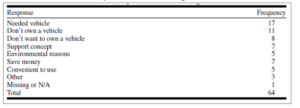
5- DISCUSSION
Road transport movements have reached a high concerned level for both individuals and societies due to energy, environmental and social negative impacts as well as economic costs. Baptista et al. (2014) found that road transit in Portugal had about 35% of the final energy consumption and CO2 emissions in 2010. Using alternative transportation such as carsharing would properly reduce the number of vehicle ownership and the fuel as well as the amount of energy consumption and CO2 emissions because carsharing vehicles tend to be more efficient than other private vehicles.
Using carsharing may alleviate the demand of own cars and reduce the daily trips. European evidences prove that members of carsharing drive less than before they became members in carsharing (Steininger et al., 1996). Individuals would travel less than they need if they had to pay for each single trip. Once people become more mindful of their trip costs, the level of travel in vehicles miles is expected to decrease (Katzev, 2003).
Carsharing has social and environment advantages for the whole community as many studies shown that the lack in transit access has bad effects on health and employment outcome (Agapitou et al. 2014). It provides easy access for low-income individuals rather than purchase a private car. Agapitou et al. (2014) states that each five private vehicles replaced by one shared car and this on itself leads to reduce the traffic congestion and parked vehicles in urban cities resulting in more open spaces for individuals. Moreover, members of carsharing organization have the flexibility to use cars and return them whenever and wherever they want.
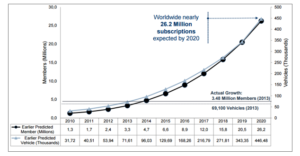
Figure (6) Carshiring vehicles and member growth 2010-2020, Frost and Sullivan, 2014
6- CONCLUSION
As studies and surveys discussed above show that car sharing has already a significant impact in different metropolitan cities on vehicle ownership, growth in markets might produce greater environmental benefits in the future (Martin & Shaheen, 2011). Carsharing minimize the potential environmental impact in Urban Cities. It provides consumer an affordable way to own a car with short-term in residential areas, as they need. As a result, it mitigates the need of ownership of household vehicles. Household members carsharing dropped by about 0.24 cars rather than 0.47 when they non-carsharing member. Carsharing is growing gradually and may extend even into lower communities and in 2020 expected to have about 26 million member and 446, 48 vehicles rather than 4 million members and 96, 03 vehicles in 2014 (figure 6) (Martin & Shaheen, 2011). Results from studies indicate that the system of carsharing could contribute in reduction ownership of private cars in urban cities (Firnkorn & Martin 2011). Thus, it shown to be beneficial in both environmental consideration and transit consideration.
7- ACKNOWLEDGMENTS
I would like to take this opportunity to express my deepest appreciation to The Saudi Arabian Cultural Mission (SACM) for giving me their valuable suggestions and support throughout my research.
8- REFERENCES
– Agapitou, C., Deftou, E., Frantzi, C., Stamatopoulou, M., Georgakellos, D. 2014. Car-Sharing as an Environmental Policy Tool: A Preliminary Analysis. International Journal of Business and Social Science, 5 (10) 38-43.
– Baptista, P., Melo, S., Rolim, C, 2014. Energy, environmental and mobility impacts of sharing systems. Empirical results from Lisbon, Portugal. Procedia – Social and Behavioral Sciences, 111(2014) 28-37.car-
– Briggs, M. & Woodland, A. (2015, June 12). “Future of Mobility: Continued Growth & Investment Potential of the Global Carsharing Market.” Frost and Sullivan. Retrieved May 2, 2016, from: http://www.slideshare.net/alanwoodland169/frost-and-sullivan.
– Firnkorn, J., and Muller, M., 2011. What will be the environmental effects of new free-floating car-sharing systems? The case of car2go in Ulm. Ecological Economics, 70, 1519-1528.
– Fellows, N.T., and Pitfield, D.E. 2000. An economic and operational evaluation of urban car-sharing. Transportation Research Part D, 5(2000) 1-10.
– Katzev, R. 2003. Car Sharing: A New Approach to Urban transportation Problems. Analyses of Social Issues and Public Policy, 3(1), 65-86.
– Le Vine, S., Zolfaghari, A., and Polak, J. 2014. Carsharing: Evolution, Challenges and Opportunities. Scientific Advisory Group Report.
– Martin, E.W., and Shaheen, S.A. 2011. Greenhouse Gas Emission Impacts of Carsharing in North America.IEEE Transactions on Intelegent Transportation systems, 12(4) 1074- 1087.
– Martin, E., and Shaheen, S. 2011. The Impact of Carsharing on Household Vehicle Ownership.ACCESS 23-27.
– Steininger, K., Vogl, C., and Zettle, R. 1996. The size of the market segment and revealed change in mobility behavior. Pergamon, 3(4), 177-185.
– Shaheen, S.A., Cohen, A.P., and Reberts, J.D. 2005. Carsharing in North America: Market Growth, Current Development, and Future Potential. Institute of Transportation Studies 1-18.
– Shaheen, S.A., and Cohen, A.P. 2008. Worldwide Carsharing Growth: An International Comparison. Institute of Transportation Studies, eScholarshio- University of California, 80-89.
– Shaheen, S., Chohen, A. 2012. Innovative Mobility Carsharing Outlook, Carsharing Market Overview, Analysis, and Trends. Transportation Sustainability Research Center 1(1) 1-4.
النتائج المترتبة عن نظام وسائل النقل المشتركة على الملكية في المدن الحضرية